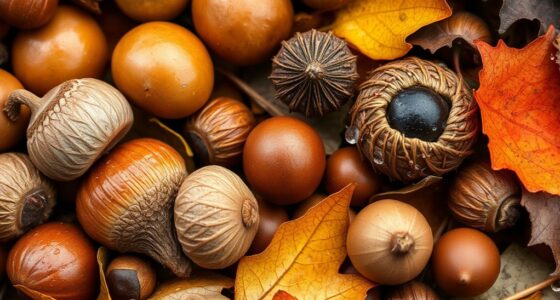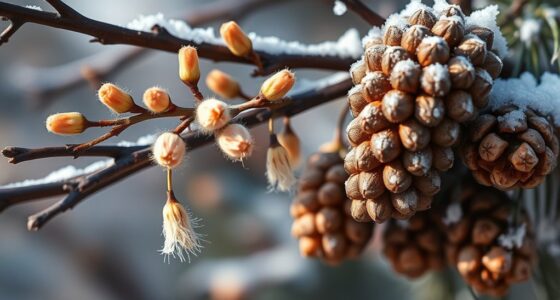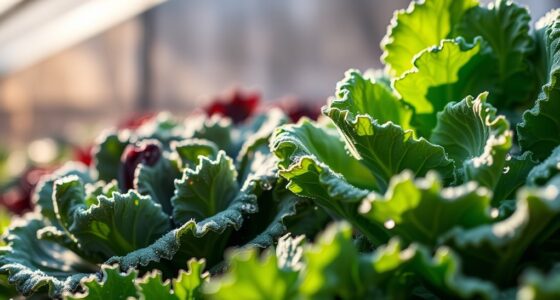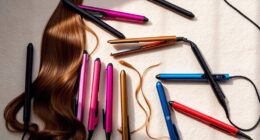Start your early spring foraging by learning to identify blooming plants like violets, wild garlic, and hepatica, paying attention to leaf shapes, flowers, and growth habits. Equip yourself with essential tools such as a sharp knife, field guide, mesh bag, and GPS, while practicing safety. Recognize fungi by habitat and features, and harvest sustainably without damaging plants. Want to discover more tips? Keep exploring to enhance your foraging experience safely and responsibly.
Key Takeaways
- Identify early spring wild edibles like violets, wild garlic, and hepatica by observing leaf shapes and flower structures.
- Carry essential tools such as a sharp knife, basket, field guide, GPS, and gloves for safe and ethical foraging.
- Learn to distinguish edible mushrooms from toxic varieties by examining habitat, cap shape, gills, and stem features.
- Harvest early bloomers like dandelions and wild leeks sustainably without damaging plants or ecosystems.
- Recognize signs of seasonal change and first fruits to optimize foraging success while respecting local regulations.
Identifying Early Spring Wild Edibles

As early spring arrives, it’s the perfect time to start identifying wild edibles that thrive during this season. Focus on spring flower identification to recognize edible blooms like violet, wild garlic, and hepatica, which often appear early. These flowers not only add color but can also be safely foraged when confident in your identification skills. Early berry harvesting begins with berries like serviceberries and elderberries, which ripen sooner than summer varieties. Pay close attention to leaf shapes, flower structures, and growth habits to distinguish edible plants from toxic look-alikes. Keep your eyes peeled for fresh, vibrant growth and subtle signs of the season’s first fruits. Additionally, understanding the wild edible plant identification process is crucial for safe foraging and a rewarding spring experience.
Essential Tools and Safety Tips

Equipping yourself with the right tools makes early spring foraging safer and more efficient. A sturdy basket or mesh bag keeps your finds fresh and allows airflow. A sharp knife helps with clean harvesting, respecting foraging ethics. Carry a small field guide to identify plants and adhere to local regulations. A compass or GPS ensures you stay on track, especially in unfamiliar terrain. Safety gear like gloves protects against thorns and irritants. Always respect foraging ethics by avoiding overharvesting. Use the table below to guide your toolkit:
| Tool | Purpose |
|---|---|
| Basket or mesh bag | Collect and carry foraged items |
| Sharp knife | Harvest plants cleanly |
| Field guide | Accurate identification |
| GPS or compass | Navigation and safety |
| Gloves | Protect hands from hazards |
Recognizing Mushrooms and Fungi
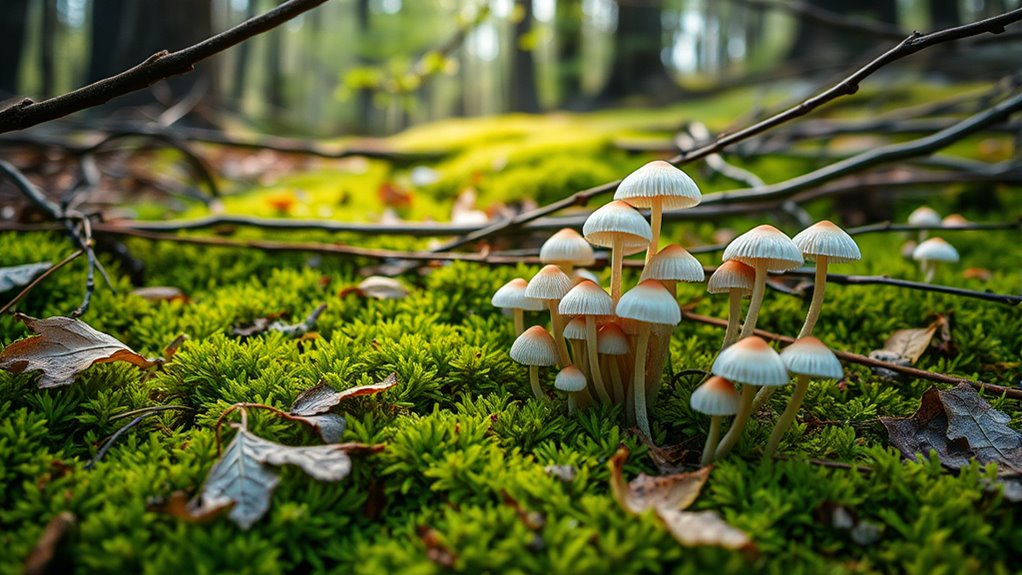
Recognizing mushrooms and fungi is essential to foraging safely and successfully. Understanding mushroom taxonomy helps you distinguish edible varieties from toxic ones, while knowledge of fungi habitats guides you to promising foraging sites. Pay attention to key features like cap shape, gills, and stem structure, as these are crucial identifiers. Incorporating sound design techniques such as detailed audio recordings of natural environments can enhance your awareness of fungal habitats and behaviors.
Seasonal Plant and Flower Foraging
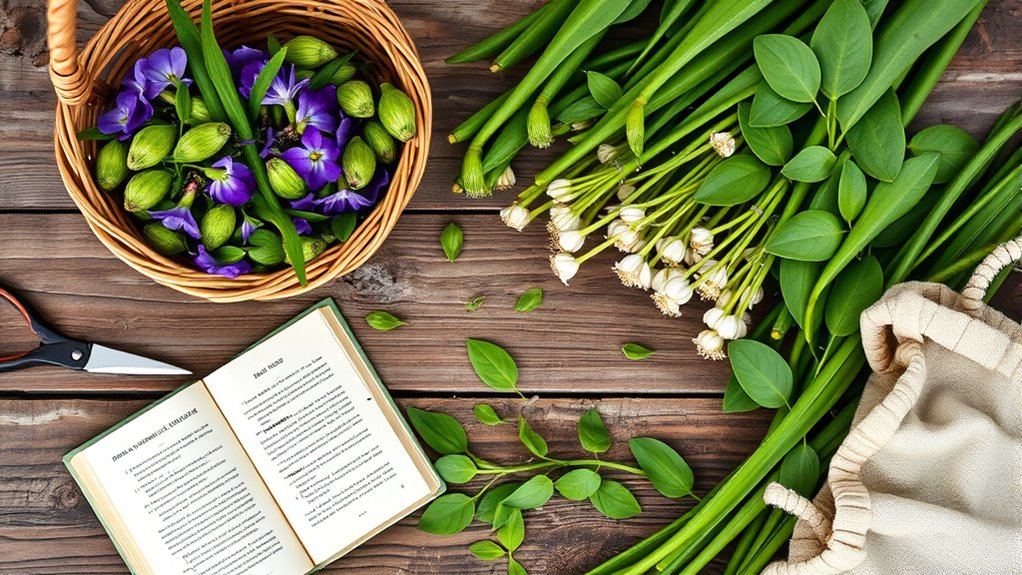
Spring is the perfect time to start foraging for seasonal plants and flowers, as many varieties emerge early in the season and offer fresh, edible options. Focus on wildflower identification to guarantee you harvest safe, edible species. Look for early bloomers like violets, wild leeks, and dandelions, which are abundant and nutritious. Picking these plants supports pollinator support by providing essential food sources for bees and butterflies emerging after winter. When foraging, avoid damaging the plants to promote healthy growth and future blooms. Always verify plant identification before consumption, and harvest sustainably to protect local ecosystems. Incorporating these seasonal plants into your diet not only enriches your foraging experience but also benefits pollinator populations critical for thriving ecosystems. Additionally, understanding environmentally sustainable harvesting methods can help ensure the longevity of these wild plants and the health of the surrounding habitat.
Frequently Asked Questions
When Is the Best Time to Start Spring Foraging?
You should start spring foraging when the weather warms and plants begin to sprout, usually in early to mid-spring. Use seasonal foraging tips to identify edible plants and always follow safety precautions—know your plants well and avoid anything that could be toxic. Pay attention to local foraging regulations and harvest sustainably. This approach guarantees you enjoy the bounty safely while respecting nature’s cycle.
How Do I Find Local Foraging Regulations?
Imagine walking through your favorite trail, leaves crunching softly beneath your feet. To find local foraging regulations, you should start by checking your state or county’s official website, which often has dedicated sections for foraging safety and legal considerations. Visiting local land management agencies or talking to community groups can also provide valuable insights, ensuring you forage responsibly and legally while respecting the environment.
Can Foraged Plants Be Used for Medicinal Purposes?
You can definitely use foraged plants for medicinal purposes, but first, focus on proper medicinal plant identification to guarantee safety. Once you’ve confidently identified the plants, you can incorporate them into herbal remedy preparation, using traditional or researched methods. Always remember to verify the plant’s effects and potential side effects before using them medicinally, and consult with a healthcare professional if you’re uncertain about any plant’s safety or efficacy.
What Are Common Mistakes to Avoid When Foraging Early Spring?
Remember, “measure twice, cut once.” When foraging early spring, you avoid common mistakes by prioritizing plant safety and ethical harvesting. Always correctly identify plants before collecting, as misidentification can be dangerous. Respect nature by taking only what you need and never overharvest. Stay informed about local regulations, and avoid plants that are endangered or protected. This mindful approach guarantees a safe, sustainable foraging experience.
How Do I Identify Invasive Plant Species During Foraging?
When doing invasive plant identification, you focus on spotting non-native species that may harm local ecosystems. Look for plants that aren’t typical for your area, especially those with unusual growth patterns or distinctive features. Use field guides or apps to compare your findings. Be cautious, as some invasive plants mimic native species. Accurate non-native species detection helps you avoid unintentionally harvesting or spreading invasive plants while foraging.
Conclusion
As you venture into early spring foraging, remember that over 70% of wild edibles are safe and nutritious when properly identified. Staying informed and cautious guarantees a rewarding experience, connecting you with nature’s bounty. Keep your tools handy and your safety first. With each outing, you’ll gain confidence and uncover new flavors. Happy foraging—embrace the season’s fresh offerings and enjoy the journey of discovering wild treasures!



